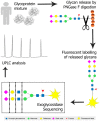Early Stage Glycosylation Biomarkers in Alzheimer's Disease
- PMID: 31484367
- PMCID: PMC6789538
- DOI: 10.3390/medicines6030092
Early Stage Glycosylation Biomarkers in Alzheimer's Disease
Abstract
Alzheimer's disease (AD) is of great cause for concern in our ageing population, which currently lacks diagnostic tools to permit accurate and timely diagnosis for affected individuals. The development of such tools could enable therapeutic interventions earlier in the disease course and thus potentially reducing the debilitating effects of AD. Glycosylation is a common, and important, post translational modification of proteins implicated in a host of disease states resulting in a complex array of glycans being incorporated into biomolecules. Recent investigations of glycan profiles, in a wide range of conditions, has been made possible due to technological advances in the field enabling accurate glycoanalyses. Amyloid beta (Aβ) peptides, tau protein, and other important proteins involved in AD pathogenesis, have altered glycosylation profiles. Crucially, these abnormalities present early in the disease state, are present in the peripheral blood, and help to distinguish AD from other dementias. This review describes the aberrant glycome in AD, focusing on proteins implicated in development and progression, and elucidates the potential of glycome aberrations as early stage biomarkers of AD.
Keywords: Alzheimer’s; Aβ; biomarker; glycosylation; tau.
Conflict of interest statement
The authors declare no conflicts of interest. The funders had no role in the design of the study; in the collection, analyses, or interpretation of data; in the writing of the manuscript, or in the decision to publish the results.
Figures


Similar articles
-
Human Brain and Blood N-Glycome Profiling in Alzheimer's Disease and Alzheimer's Disease-Related Dementias.Front Aging Neurosci. 2021 Oct 27;13:765259. doi: 10.3389/fnagi.2021.765259. eCollection 2021. Front Aging Neurosci. 2021. PMID: 34776937 Free PMC article.
-
N-glycan and Alzheimer's disease.Biochim Biophys Acta Gen Subj. 2017 Oct;1861(10):2447-2454. doi: 10.1016/j.bbagen.2017.04.012. Epub 2017 Apr 29. Biochim Biophys Acta Gen Subj. 2017. PMID: 28465241 Review.
-
Alzheimer's disease.Subcell Biochem. 2012;65:329-52. doi: 10.1007/978-94-007-5416-4_14. Subcell Biochem. 2012. PMID: 23225010 Review.
-
Reciprocal Predictive Relationships between Amyloid and Tau Biomarkers in Alzheimer's Disease Progression: An Empirical Model.J Neurosci. 2019 Sep 11;39(37):7428-7437. doi: 10.1523/JNEUROSCI.1056-19.2019. Epub 2019 Jul 26. J Neurosci. 2019. PMID: 31350262 Free PMC article.
-
Soluble pre-fibrillar tau and β-amyloid species emerge in early human Alzheimer's disease and track disease progression and cognitive decline.Acta Neuropathol. 2016 Dec;132(6):875-895. doi: 10.1007/s00401-016-1632-3. Epub 2016 Oct 21. Acta Neuropathol. 2016. PMID: 27770234 Free PMC article.
Cited by
-
The N-glycan profile in cortex and hippocampus is altered in Alzheimer disease.J Neurochem. 2021 Oct;159(2):292-304. doi: 10.1111/jnc.15202. Epub 2020 Oct 24. J Neurochem. 2021. PMID: 32986846 Free PMC article.
-
Mortality Risk Profiling of Staphylococcus aureus Bacteremia by Multi-omic Serum Analysis Reveals Early Predictive and Pathogenic Signatures.Cell. 2020 Sep 3;182(5):1311-1327.e14. doi: 10.1016/j.cell.2020.07.040. Cell. 2020. PMID: 32888495 Free PMC article.
-
Glycan Mimetics from Natural Products: New Therapeutic Opportunities for Neurodegenerative Disease.Molecules. 2019 Dec 16;24(24):4604. doi: 10.3390/molecules24244604. Molecules. 2019. PMID: 31888221 Free PMC article. Review.
-
N-Glycomics of Cerebrospinal Fluid: Method Comparison.Molecules. 2021 Mar 19;26(6):1712. doi: 10.3390/molecules26061712. Molecules. 2021. PMID: 33808573 Free PMC article.
-
Implications of Glycosylation in Alzheimer's Disease.Front Neurosci. 2021 Jan 13;14:625348. doi: 10.3389/fnins.2020.625348. eCollection 2020. Front Neurosci. 2021. PMID: 33519371 Free PMC article. Review.
References
-
- World Health Organization Dementia. [(accessed on 1 March 2018)]; Available online: http://www.who.int/en/news-room/fact-sheets/detail/dementia.
-
- Alzheimer’s Association What Is Alzheimer’s? [(accessed on 15 January 2018)]; Available online: https://www.alz.org/alzheimers_disease_what_is_alzheimers.asp.
Publication types
Grants and funding
LinkOut - more resources
Full Text Sources

